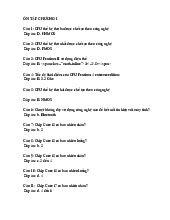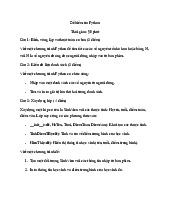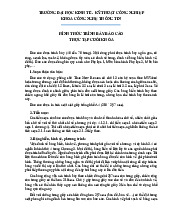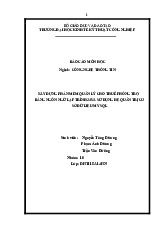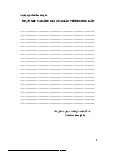














Preview text:
WEEK 1
VIDEO: Welcome to the Google Data Analytics Certificate
What do companies in e-commerce, entertainment, healthcare,
manufacturing, marketing, finance, tech, and hundreds of other industries all have in common?
They all use data. Organizations of all kinds need data analysts to help
them improve their processes, identify opportunities and trends, launch new
products, provide great customer service, and make thoughtful decisions.
Hi, I'm Tony, a program manager at Google and a data analyst myself. I like
to welcome you to the Google Data Analytics Certificate. Now, there are lots
of great reasons to earn this certificate. Maybe you're thinking about starting a
career in the exciting world of data analytics, or maybe you're just fascinated by
the power of data as I am. No matter what brought you here, you're in the right
place to kick-start a career and learn industry-relevant skills in data analytics.
But first, what exactly is data?
Well, I'll like to say that data is a collection of facts. This collection can
include numbers, pictures, videos, words, measurements, observations, and
more. Once you have data, analytics puts it to work through analysis. Data analysis
is the collection, transformation, and organization of data in order to draw
conclusions, make predictions and drive informed decision-making. And it doesn't
stop there. Data evolves over time which means this analysis or analytics, as we
call it, can give us new information throughout data's entire life cycle. Data is
everywhere. You use and create data everyday. Have you ever read reviews of a
product before deciding whether or not to buy it? That's data analysis. Or maybe
you wear a fitness tracker to count your steps so you can stay active throughout the
day. That's data analysis. But you don't just use data. You also create huge amounts
of it every single day. Any time you use your phone, look up something online,
stream music, shop with a credit card, post on social media or use GPS to map a
route, you're creating data. Our digital world and the millions of smart devices
inside of it have made the amount of data available truly mind-blowing. Here at
Google we process more than 40,000 searches every second. That's 3.5 billion
searches a day and 1.2 trillion searches every year. Here's another way to
think about it. YouTube has almost two billion users. If YouTube users made
up a country, it would be the largest in the world. All of that data is
transforming the world around us. The publication The Economist recently
called data the world's most valuable resource. It's easy to see why data
analysts are so valued by their organizations.
What exactly does a data analyst do?
Put simply, a data analyst is someone who collects, transforms, and organizes
data in order to help make informed decisions. Besides the role itself, one of the most
exciting parts of being a data analyst is the number of opportunities available. The
demand for data analysts is greater than the number of qualified people to fill these
job openings. This certificate program is a great first step in your journey to finding a
job you love. Data analysts come from many different backgrounds and have all
kinds of life experiences. You don't need decades of work experience or an expensive
education to get started. Many data analysts taught themselves the skills they needed
to land their first job, just like you're doing right now. Now let's talk more about what
you're going to learn. The Google Data Analytics Certificate is split into courses
based on different processes for data analysis. Those are ask, prepare, process,
analyze, share, and act. Plan to watch these videos in order. Each one covers a new
topic and every topic builds on what you've learned before, making it easy to track
your progress. You're in the driver's seat. Even though you might see things
organized by weeks, everything can be completed at your own pace. So you decide
how much you want to do each day. By the end of the program, you'll take everything
you've learned and turn it into a project that you can use to show off your skills, and
wow hiring managers at your job interviews. Now along the way you'll also hear
from Googlers. That's what we call people who work here at Google. They'll give you
an inside look at what it's like to work in our industry and share personal stories of
how they got into the field. They'll also give you some excellent tips on how to land
your dream job. Stay tuned. Some of them are going to introduce themselves in just a sec.
I'm Angie. I'm a program manager of engineering at Google. I truly
believe that cleaning data is the heart and soul of data. It's how you get to know
your data, its quirks, its flaws, its mysteries. I love a good mystery. It felt like a
superpower almost. I was a detective and I had gone in there and I'd really solved something.
Hi, I'm Alex. I'm a research scientist at Google. I research the
different impacts of artificial intelligence on society and our users.
My name is Lilah Jones. I'm a part of our cloud team. I get a chance to
lead a team of amazing individuals that are focused on helping customers get to the cloud.
Hi, I'm Evan. I'm a learning portfolio manager here at Google. I have one
of the coolest jobs in the world where I get to look at all the different
technologies that affect big data and then work them into training courses like this one for students to take.
I'll be your instructor for the first course. I'll take you through each module
that will cover a specific topic in a few different ways. You'll have videos, reading
materials, quizzes, hands-on activities, and discussion prompts for you to chat about
with other students in an online forum. I'm really excited to be guiding you through
this course, but I'm especially excited that you've chosen this adventure.
Lifelong learning is something that I'm very passionate about. Growing up,
when I looked around, I often didn't see many options available to me. It wasn't until
I started getting serious about my education that I realized I had the control to make
my own opportunities with education being the key that would open those doors. The
more I learned and the harder I worked, the more possibilities opened up. Had I not
gone after that knowledge and continued challenging myself, I may not be where I
am today. Learning allowed me to grow personally, be successful, visit places I
would never have seen, and meet people I would never have known. Now I'm going
to introduce some of those great people.
Hello, I'm Ximena, financial analyst. I'll be helping you learn how to ask
the right questions about data, the project you work on and the problems you're trying to solve.
Hey, my name is Hallie, analytical lead. I'm so excited to show you
how to prepare your data so it's ready for analysis.
Hello, I'm Sally, measurement and analytical lead. Together we'll cover
how to process and clean your data. Cleaning data doesn't require soap and
water. I'm talking about making sure your data is complete, correct, and
relevant to the problem you're trying to solve.
Hey, I'm Ayanna, global insights manager. We'll be digging into
analysis. You'll learn how to collect, transform, and organize data so that
you can use it to discover useful information, draw conclusions, and make great decisions.
My name's Kevin and with my experience as Director of analytics at
Google, I'll guide you through what I think is the most exciting part of the
data analysis process: plan, create, and present effective and compelling data visualizations.
Hello, my name is Carrie. I can't wait to tell you about all the exciting
things you can do with the programming language R. Are you ready?
Hi, I'm Rishie, Global analytics skills curriculum manager. I'm going to
help you bring together everything you learned during this program by creating
a case study that will dazzle any hiring manager. Just like the capstone of a great
building shows everyone that it's complete, your case study will signify your
own great achievement of earning a Google certificate in data analytics.
Okay, are you getting excited about the potential of becoming a data
analyst? So much is possible with data. You're about to enter a whole new world. Ready? Let's go.
READING: Program description and course syllabus
Hello and welcome! The program you are about to explore is specifically
designed to help every type of learner successfully finish the certificate and
become an entry-level junior or associate data analyst. No previous data
analytics, mathematics, or statistical experience is required. To succeed, you just
need to be open to learning how data influences the world. Become job-ready
Every day, the amount of data out there gets bigger and bigger. So the ability to
interpret it effectively is more important than ever before. Data analytics is becoming
one of the fastest-growing and most rewarding career choices in the world. In the next
decade, the demand for business analytics skills will probably be higher than the
demand for any other career (10.9% vs. 5.2%) (Source: Bureau of Labor Statistics).
All kinds of companies all over the world need qualified data analysts to solve
problems and help them make the best possible business decisions. And right now,
fifty-nine percent of companies have plans to add even more positions requiring data
analysis skills (Source: SHRM). By the time you are done with this program, you will
be well-prepared to make smart, strategic, data-driven recommendations for
organizations in all kinds of industries.
During each course of the program, you will complete lots of hands-on
assignments and projects based on both day-to-day life and the practical
activities of a data analyst. Along the way, you will learn how to ask the right
questions and understand objectives. You will also learn how to effectively
clean and organize large amounts of data to make it ready for high-quality
analysis. On top of that, you will get hands-on experience using all kinds of
tools and techniques that will help you recognize patterns and uncover
relationships between data points. And to help you communicate the results of
your analysis, you will learn how to design visuals and dashboards. There is
even an opportunity to create a case study, which you can highlight in your
resume to show what you have learned to potential employers. Course overview
The entire program has eight courses. This is the first course and it covers about five weeks of material.
1. Foundations: Data, Data, Everywhere (this course)
2. Ask Questions to Make Data-Driven Decisions
3. Prepare Data for Exploration
4. Process Data from Dirty to Clean
5. Analyze Data to Answer Questions
6. Share Data Through the Art of Visualization
7. Data Analysis with R Programming
8. Google Data Analytics Capstone: Complete a Case Study Course content
Course 1– Foundations: Data, Data, Everywhere
1. Introducing data analytics: Data helps us make decisions, in everyday life
and in business. In this first part of the course, you will learn how data
analysts use tools of their trade to inform those decisions. You will also get to
know more about this course and the overall program expectations.
2. Thinking analytically: Data analysts balance many different roles in
their work. In this part of the course, you will learn about some of these
roles and the key skills that are required. You will also explore analytical
thinking and how it relates to data-driven decision making.
3. Exploring the wonderful world of data: Data has its own life cycle, and
data analysts use an analysis process that cuts across and leverages this
life cycle. In this part of the course, you will learn about the data life cycle
and data analysis process. They are both relevant to your work in this
program and on the job as a future data analyst. You will be introduced to
applications that help guide data through the data analysis process.
4. Setting up a data toolbox: Spreadsheets, query languages, and data
visualization tools are all a big part of a data analyst’s job. In this part of
the course, you will learn the basic concepts to use them for data analysis.
You will understand how they work through examples provided.
5. Discovering data career possibilities: All kinds of businesses value the work
that data analysts do. In this part of the course, you will examine different
types of businesses and the jobs and tasks that analysts do for them. You will
also learn how a Google Data Analytics Certificate will help you meet many of
the requirements for a position with these organizations.
6. Completing the Course Challenge: At the end of this course, you will
be able to put everything you have learned into perspective with the
Course Challenge. The Course Challenge will ask you questions about
the main concepts you have learned and then give you an opportunity to
apply those concepts in two scenarios. What to expect
Each week of the course includes a series of lessons with many types of
learning opportunities. These include:
Videos for instructors to teach new concepts and demonstrate the use of tools
Readings to introduce new ideas and build on the concepts from the videos
Discussion forums to share, explore, and reinforce lesson topics for better understanding
Discussion prompts to promote thinking and engagement in the discussion forums
Practice quizzes to prepare you for graded quizzes
Graded quizzes to measure your progress and give you valuable feedback
Also, be sure to pay attention to the in-video questions that will pop up
from time to time. They are designed for you to check your learning.
Everyone learns differently, so this program has been designed to let you work at
your own pace. Although your personalized deadlines start when you enroll, they
are just a guide. Feel free to move through the program at the speed that works
best for you. There is no penalty for late assignments; to earn your certificate, all
you have to do is complete all of the work. If you prefer, you can extend your
deadlines by returning to Overview in the navigation panel and clicking Switch
Sessions. Assessments are based on the approach taken by the course to offer a
wide variety of learning materials and activities that reinforce important skills.
Graded and ungraded quizzes will help the content sink in. Ungraded practice
quizzes are a chance for you to prepare for the graded quizzes. Both types of
quizzes can be taken more than one time.
Optional speed track for those experienced in data analytics
The Google Data Analytics Certificate provides instruction and feedback for
learners hoping to earn a position as an entry-level data analyst. While many
learners will be brand new to the world of data analytics, others may be
familiar with the field and simply wanting to brush up on certain skills.
If you believe this course will be primarily a refresher for you, we recommend
taking the practice diagnostic quiz (you can find it in this week's content). It will
enable you to determine if you should follow the speed track, which is an
opportunity to proceed to Course 2 after having taken each of the Course 1
Weekly Challenges and the overall Course Challenge. Learners who score 100%
on the diagnostic quiz can treat Course 1 videos, readings, and activities as
optional. Learners following the speed track are still able to earn the certificate. Tips
It is strongly recommended to take these courses—and go through the
items in each lesson—in the order they appear because new information
and concepts build on previous knowledge.
Use the additional resources that are linked throughout the program.
They are designed to support your learning.
When you encounter useful links in the course, remember to bookmark
them so you can refer to the information for study or review.
Additional resources are free, but some sites place limits on how many
articles can be accessed for free each month. Sometimes you can register
on the site for full access, but you can always bookmark a resource and come back to view it later.
If something is confusing, don’t hesitate to re-watch a video, go
through a reading again, and so on.
Take part in all learning opportunities to gain as much knowledge and experience possible.
Congratulations on choosing to take this first step toward becoming part of
the wonderful world of data analytics. Enjoy the journey!
READING: Learning Log: Think about data in daily life Overview
By now, you've started to discover how powerful data can be. Throughout this
course, you’ll be asked to make entries in a learning log. Your log will be a personal
space where you can keep track of your thinking and reflections about the
experiences you will have collecting and analyzing data. Reflections may include
what you liked, what you would change, and questions that were raised. By
the time you complete the entry for this activity, you will have a stronger
understanding of data analytics. Everyday data
Before you write an entry in your learning log, think about where and how you
use data to make decisions. You will create a list of at least five questions that
you might use data to answer. Here are a few examples to inspire you:
What’s the best time to go to the gym?
How does the length of your commute to work vary by day of the
week? How many cups of coffee do you drink each day?
What flavor of ice cream do customers buy?
How many hours of sleep do you get each day?
Then, you will select one of the five questions from your list to explore further
and write down the types of data you might collect in order to make a decision.
That’s data analysis in action!
Access your learning log
To use the learning log for this course item, click the link below and select Use Template.
Link to learning log template: Think about data in daily life
If you don’t have a Google account, you can download the template directly from the attachment below. Reflection
After you consider how you use data analysis in your own life, take a moment to
reflect on what you discovered. Reflections may include what you liked, what you
would change, and questions that were raised. In your new learning log entry, you
will write 2-3 sentences (40-60 words) in response to each question below:
What are some considerations or preferences you want to keep in mind when making a decision?
What kind of information or data do you have access to that will influence your decision?
Are there any other things you might want to track associated with this decision?
When you’ve finished your entry in the learning log template, make sure to save
the document so your response is somewhere accessible. This will help you
continue applying data analysis to your everyday life. You will also be able to
track your progress and growth as a data analyst. Example
Since this is your first learning log, an example has been provided using one of
the questions above to help you.
Link to learning log example: Think about data in daily life
If you don’t have a Google account, you can download the example directly from the attachment below.
VIDEO: Introduction to the course
"Data! Data! Data! I can't make bricks without clay." Any guesses who said this? I'll
give you a hint. It wasn't a famous tech CEO, or a data analyst. The person who said
this lived long before the tech companies even existed. But I bet you've still heard of
him. This line was said by Sherlock Holmes, the famous detective created by Sir
Arthur Conan Doyle. What Doyle meant was that Holmes couldn't draw any
conclusions, which would be the bricks he mentioned without data, or the clay. You're
probably not here to become a world famous detective, but data is still the building
block that you'll use for everything you do in your new data analyst career, Sherlock
Holmes would agree. By starting this program, you've shown that you and Sherlock
Holmes have something in common, you both have an interest in learning more.
That's one of the most important qualities that data analysts can have. Now, there are
a bunch of different ways to explore data, but one of the great things about data
analytics is that you can often learn how you want, when you want. That might mean
doing your own research, talking with people in the industry, or taking online courses.
With that said, welcome to your first course.
This is your introduction to the wonderful world of data analytics. Since data
analytics is the science of data, you'll use this course to begin to learn all about
data. Data is basically a collection of facts or information, and through analysis, you'll
learn how to use the data to draw conclusions, and make predictions, and decisions.
Personally, I didn't jump right into the data analytics field. I thought data analysis was
for computer engineers. Instead, I started off with dreams of working in finance. Once
I got through an internship though, I realized it wasn't the career path I wanted to take.
I started to learn about financial planning and analysis, and all of the work finance
analysts were doing with data. I realized that finance analysts are really just data
analysts working in a finance department. These analysts were helping to guide
business decisions by knowing how to use data. It was then I realized how powerful
data is, and I started to embrace it. Soon enough, I realized I could do this data
analysis myself. Data analytics is a big open world of opportunity. There are so many
areas that your analysis skills can be applied and in all different ways. If you're new to
this world, you'll learn how to identify which path and industry might suit your skills,
and your interests the best. For those of you who already have some experience, we'll
help you open doors to new and exciting opportunities. One of the skills you'll gain
from the program is how to follow the best practices that analysts use to help make
data-driven decisions. Computers are one part of the process, but analysts rely on so
much more to make decisions. That's why learning how to think analytically, and
using your other skills and traits on the job will make your work easier. I know you
already know how to make good decisions, you chose to be here after all. In this first
course, you'll learn more about each phase of the data analysis process. Ask, prepare,
process, analyze, share, and act. As a data analyst, you'll go through these steps as you
use data to inform your decisions. Eventually, you'll see how this program itself is in
a way, its own version of this process. While I know you'll enjoy watching these
videos, your trip to the first course will include a whole lot more. Other videos will
take the form of vignettes, where you'll learn from data analytics professionals, who
are already established in their careers. They'll offer words of wisdom as well as tales
of their own experiences starting off on their career path. You'll start your own data
journal that will help you keep track of what you've learned throughout the course.
You'll also add your own thoughts about what you're learning as well, throughout the
program. You'll read up on how to navigate this program in the world of data
analytics. You'll complete activities, including some that will help you get in the
mindset of a data analyst. Along the way, you'll also have the chance to connect with
your fellow learners. Discussion prompts will give you a chance to share your
thoughts, and at the same time see what your peers think about all that you're
